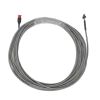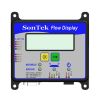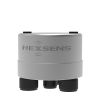SonTek-IQ Series Acoustic Doppler Flow Meters
Features
- Self-contained all-in-one design
- Proprietary flow algorithms for irrigation canals, natural streams and pipes
- Uses SonTek's exclusive SmartPulseHD adaptive sampling
- Expedited repair and warranty service
- Lifetime technical support
- More
Overview
The SonTek-IQ Series Acoustic Doppler Flow Meters are ideal for monitoring flows in canals, culverts, pipes, and natural streams. Four velocity beams profile water velocity along both the length and width of the channel, to ensure the best possible coverage and most accurate representation of the velocity field. The built-in pressure sensor and vertical acoustic beam work in tandem to measure water level. Simply input the channel geometry using the intuitive SonTek-IQ software and you are outputting flow data in minutes.
Mechanics
Capable of working both in man-made as well as natural channels, the SonTek-IQ can collect flow (area-velocity) and volume data in as little as 8 cm (3 in) of water. Its five-beam pulsed Doppler design is Modbus, SDI-12, RS232 and Analog ready. The SonTek-IQ installs with limited or no earthworks. With the SonTek-IQ, expect to get quality data for quality decision-making.
The SonTek-IQ Standard, the SonTek-IQ Plus and SonTek-IQ Pipe all operate at 3 MHz. The Standard model works in depths up to 1.5 m (5 ft), while the Plus and Pipe models are ideal for water depths up to 5m (16 ft). The SonTek-IQ Plus/Pipe also incorporates advanced post-processing functions, providing deeper insight into your flow and volume data. All models use SonTek's proprietary algorithm SmartPulseHD.
Benefits
- Self-contained all-in-one design
- Proprietary flow algorithms for irrigation canals, natural streams and pipes
- Uses SonTek's exclusive SmartPulseHD adaptive sampling
- Self-calibrating water level using vertical acoustic beam and pressure
- Standard package includes the SonTek-IQ, IQ software, easy mounting hardware, cable, adaptor and power supply
In The News
Source Water Monitoring in Albany, New York: Tracing Water Quality throughout Tributaries
Thousands of US cities pull their drinking water from natural source waters like reservoirs, rivers, and streams, making overall watershed health a key consideration for water providers. In Albany, New York, the Albany Department of Water and Water Supply delivers drinking water to over 100,000 residents as well as monitors and manages the larger drinking water supply watershed. Hannah Doherty, Environmental Specialist at the Albany Department of Water and Water Supply , spends her days working with a small team to monitor the drinking supply and the connected water bodies. Doherty explains, “We’re the first to encounter the water that ends up being the drinking water.
Read MoreWildfire Prevention in the Sierra Nevada Region with the Yuba Watershed Institute
Though recent wildfires have sparked new conversations about wildfire management and response, groups like the Yuba Watershed Institute have been monitoring the forests and water resources of the Sierra Nevada region for decades, managing approximately 5,000 acres of land with the Bureau of Land Management (BLM) and about 7,000 acres in private land partnerships. The goal of the Institute is to work with local communities and land agencies to improve watershed and forestry management through informed practices and public outreach. The goals of the Yuba Watershed Institute are three-fold: Improve the ability of fire suppression agencies like the California Department of Forestry and Fire Protection ( CAL FIRE ) and the US Forest Service.
Read MoreWave Sensors Integration with NexSens Buoys: A Cutting-Edge Solution for Wave Measurment
Real-time wave data supports accurate weather prediction, safe and efficient maritime operations, and provides valuable safety and operating condition information for recreation and commercial fishing. Understanding wave dynamics also helps with the design of protective coastal structures like seawalls, breakwaters, and jetties. It also supports better prediction of their impact on sediment transport and coastal geomorphology. Wave data is a key factor in qualifying and designing offshore wind farms and harnessing kinetic energy for electrical generation. It helps with the understanding of ocean-atmosphere interactions and contributes to studies of sea-level rise and climate change impacts.
Read More


















